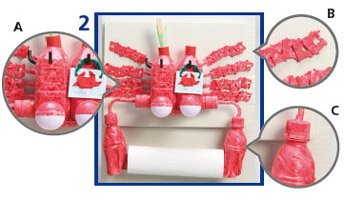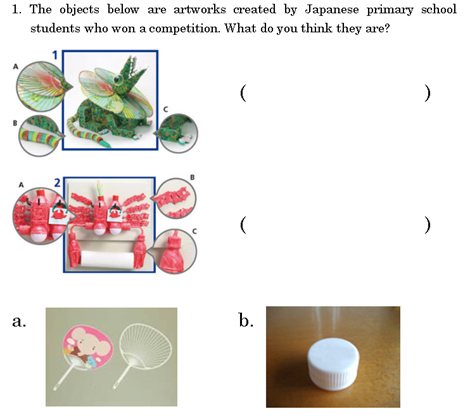Let's think what you can do for environment! (for senior)
Author:Nishimura-Parke, Yoko(Senior Learning Design Officer, Learning Design and Services Centre for Learning Innovation, NSW, Australia)
Topic/Goals:Global Issues、Link with Outside of Classroom、Social Environment
2010.06
Students read "大学生のかんきょう活動" and explore Japanese young people's involvement in activities that help the environment. Then students explore the interview though various activities, which include creating an overview of the interview, matching key expressions, completing multiple choice, comparing and reflecting how people help the environment in Japan and student's local area, writing an email or creating a short play which illustrates their activities.
Through studying this interview, students are encouraged to reflect and discuss what they are already doing and further explore ideas that help the environment.
| Objectives | ・Deduce and learn the expressions used in the interview by completing the activities. |
|---|---|
| Target | Senior |
| Japanese Level | Basic-intermediate |
What to prepare
"Ecocon: Connecting for the Enviornment"
(Word形式) (PDF形式)
- Handout 1 (Word format)
- Handout 2 (Word format)
Procedure
Activity 1: Warming up activity--Before reading the interview
Distribute Handout 1.
- The objects below are artworks created by Japanese primary school students who won a competition. What do you think they are?
(1)

(2)

Can you guess what they recycled to make these objects? Choose the correct materials for each object.
Handout 1
Handout 1
(Word format) - Look at the photos and guess what they are. Share your ideas with your classmates.
( 1 ) ( 2 ) ( 3 ) ( 4 )
- Match each photo to its description.
Handout 2

Handout 2
(Word format) - Discuss and choose one of the above to introduce in your local area to help environment. Explain why you chose the item.
Activity 2: Getting the overview of the Interview
Distribute Handout 2.
- There are 4 questions in this interview. Study only the interview questions with the class. Draw up a table on the board with columns for 'Interview Questions,' 'Answers' and 'Unfamiliar Expressions' (see sample table below). Fill in the 'Interview Questions' column.
- Students choose a section which they find most interesting and reads it thoroughly first. Alternatively, teacher can allocate sections to students. Then in English, students fill in the 'Answers' column with a summary of each interview answer. Also, they can write any sentence patterns and expressions unfamiliar to them in the 'Unfamiliar Expressions' column.
- At the end of this activity, students will be able to see the overview of the interview, and the list of unknown expressions that they need to focus on.This overview can be useful when they answer the language questions and participate in group discussions.
The sample table:
| Interview questions | Answers | Unfamiliar expressions |
|---|---|---|
| Question 1 2008年のエココンには何団体が参加しましたか。 | ||
| Question 2 | ||
| Question 3 | ||
| Question 4 |
Activity 3: Activities for language and content of the Interview
- Match the Japanese word to its English equivalent.
- What do you think エココン(Ecocon) stands for? Choose the most appropriate answers.
(1)エコin エココン stands for a. Economy b. Ecology c. Echo
(2)コンin エココン stands for a. Concert b. Control c. Contest - Explain about エココンof December 2008. How many groups participated and how did they select the winner?
- Give examples of activities of winners of エココン(Ecocon) in the last couple of years.
- What made Keita and Asuka take part in organizing エココン(Ecocon)?
- Keita mentioned; わりばしをやめるために、マイはしを持ってあるいたり、レジぶくろをやめるために、マイバッグを持ってあるいたりする
- What are わりばし and マイはし, and how do they affect the environment?
- What are レジぶくろ and マイバッグ, and how do they affect the environment?
- Explain, in English, how Keita's attitude towards environmental issues changed since he started working onエココン
- What sort of comments does Asuka receive from the participants of Ecocon? How did these comments influence her value and future plans?
Activity 4: Discussions and creative tasks
| (1)かんきょう (2)活動 (3)活性化(かっせいか)する (4)団体(だんたい) (5)さんかする (6)はっぴょうする (7)賞(しょう)をもらう (8)協力(きょうりょく)する (9)電気 (10)ちきゅう (11)社会 (12)もくひょう (13)社会人 (14)もんだい (15)えいきょう |
a. to participate b. adult, member of society c. electricity d. to receive a prize e. society f. influence g. activity h. to present i. environment j. the Earth k. cooperate, work l. group m. aim n. to activate together o.issues, problems |
|---|
- Group work: Discuss what you and your family do to help the environment. Make a list of what your group does to help the environment. (Ask your teacher whether you can do this in Japanese or in English.) Watch the past winners' performances of エココン(Ecocon). http://www.ecocon.info/application/finalist.html(写真をクリックすると発表風景が見られます)
- Are any of the ideas presented at Ecocon similar or different to what your group discussed? In what way are they similar or different?
- Which ideas from Ecocon would you like to recommend in your local community?
- Which ideas from your list would you like to promote to Japanese people?
- You decide to enter エココン(Ecocon) next year.
- Write a submission to Keita and Asuka outlining your ideas and your effort to help the environment. OR
- Create a short play to perform at エココン(Ecocon). The maximum time limit is 5 minutes.
- set the storyline to show your unique activity to help the environment
- write the script in Japanese
- decide each member's role
- practise several times
- perform in front of the class
- Keita and Asuka want to know what overseas people do for the environment. Write an email about what you and your local community do to help environment. You may express your thoughts on what Keita and Asuka are doing.
Then discuss the following points:
Answers
| Activity 1-1 | (1)-a,b (2)-c,d,e |
|---|---|
| Activity 1-3 | (1)-4, (2)-1, (3)-3, (4)-1 |
| Activity 3-1 | (1)-d, (2)-a, (3)-j, (4)-h, (5)-b, (6)-c, (7)-f, (8)-I, (9)-c, (10)-g |
| Activity 3-3 | (1)-b, (2)-c |









